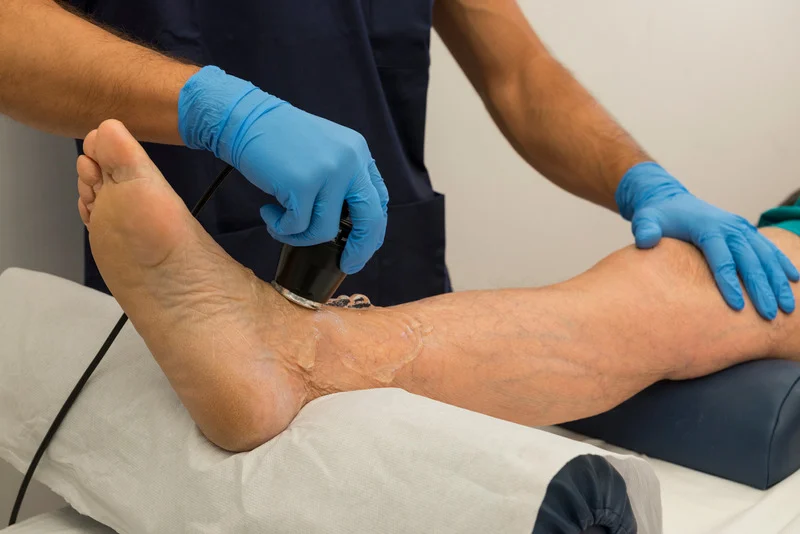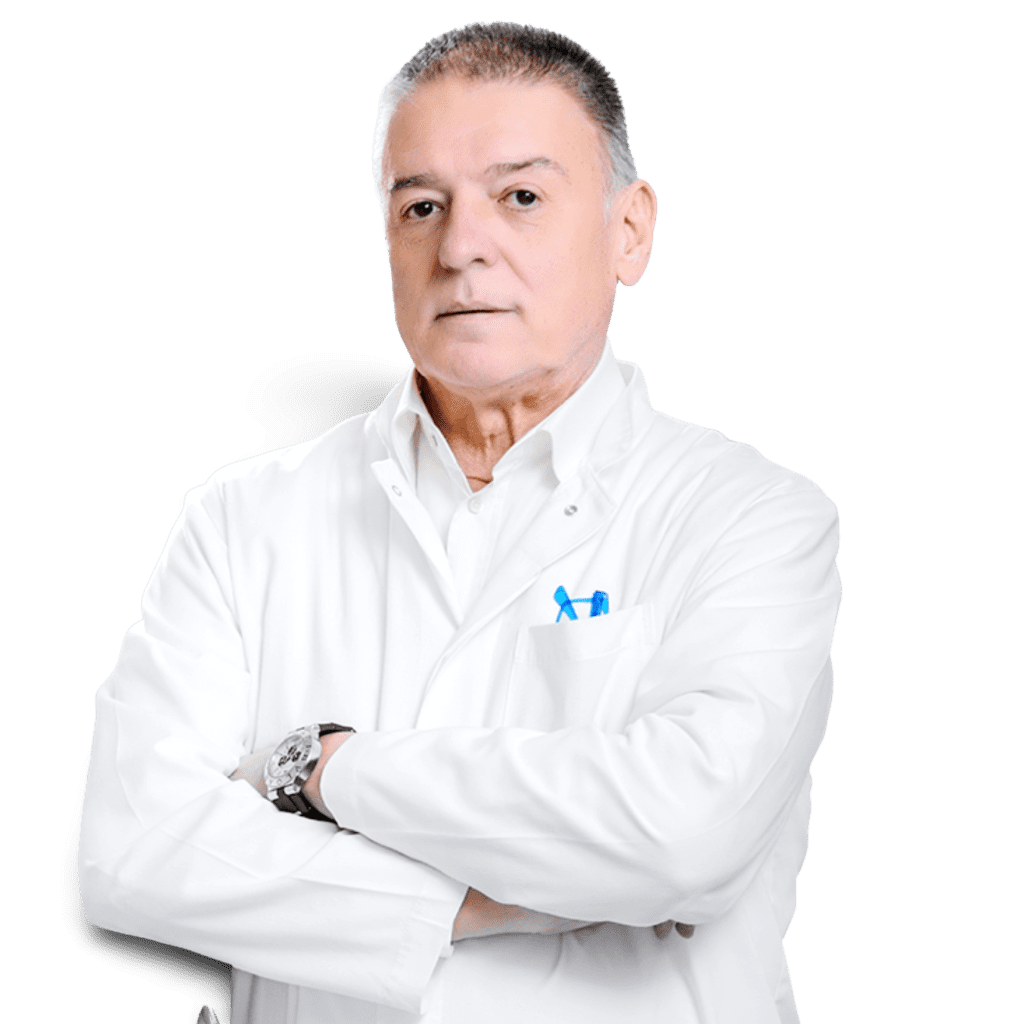WHAT CAUSES IT AND HOW CAN IT BE TREATED?
Ankle Pain
The ankle is a complex joint that allows us to walk, run, jump, and move our feet. It’s formed by the connection of three bones—the tibia and fibula in the lower leg, and the talus in the foot. These bones are linked by a network of ligaments that provide stability and enable a wide range of motion. Injuries or conditions affecting the ankle joint can significantly impact mobility and quality of life.
What Typically Causes Ankle Pain?
Achilles Tendon
Injuries to the Achilles tendon—ranging from inflammation to partial or complete rupture—can significantly impair mobility and reduce quality of life. Achilles tendinitis is typically caused by overuse or excessive strain and leads to pain and stiffness in the back of the lower leg. Ruptures often occur suddenly, as a result of abrupt, forceful movements that overstretch or tear the tendon.
Common symptoms include pain, swelling, difficulty walking, and an inability to flex the foot. Risk factors include sudden increases in physical activity, age, gender (men are more susceptible), tight calf muscles, certain medications, and underlying medical conditions such as rheumatoid arthritis or diabetes.
Diagnosis is based on clinical examination and imaging.
Treatment begins immediately with targeted physical therapy. Depending on the severity, it may also involve medication, orthotic support, or—in rare cases—plaster immobilization. Surgical intervention is only required in a small number of cases.
Ankle Sprains
An ankle sprain is one of the most common musculoskeletal injuries. It occurs when the ligaments that support the joint are overstretched or torn—partially or completely—due to sudden, uncontrolled movement of the ankle. These injuries typically result from twisting or turning the ankle unexpectedly, landing improperly, tripping, or falling while the foot is bearing weight. Sprains are classified as mild, moderate, or severe, depending on the extent of ligament damage. Milder cases are usually managed without surgery, while severe sprains involving damage in multiple directions may require surgical intervention.
Symptoms include pain, swelling, limited mobility, and difficulty bearing weight on the affected leg. Joint instability may also be present, depending on the severity.
Diagnosis is made through physical examination and confirmed with X-ray imaging; if necessary, an MRI may be used to assess more complex injuries.
Treatment typically includes early physical therapy, medication as needed, cryotherapy, and immobilization. Recovery time varies: for mild sprains, it usually takes about one week, while severe cases—especially those requiring surgery—may require up to 12 weeks, depending on the extent of the injury
Haglund’s Heel
Haglund’s deformity, also known as Haglund’s heel or “pump bump,” is a bony enlargement at the back of the heel (calcaneus) that causes pain and inflammation in the surrounding soft tissues—most often affecting the Achilles tendon and/or the retrocalcaneal bursa.
Common causes include hereditary predisposition, foot biomechanics (such as high arches), tight Achilles tendons, overpronation, and repetitive trauma from wearing rigid or ill-fitting shoes.
Symptoms typically include pain and swelling at the back of the heel, redness and inflammation around the Achilles tendon, discomfort when wearing certain types of shoes, and restricted ankle mobility. Diagnosis is made through clinical examination and diagnostic imaging..
Treatment involves physical therapy, footwear modification, anti-inflammatory medications, and corticosteroid injections in more severe cases (with caution in patients with high blood pressure, elevated blood sugar, glaucoma, etc.).
In the most severe cases, surgery may be required—such as removal of the bony prominence through calcaneal osteotomy.
Effusion
Effusion, or accumulation of fluid in the ankle joint, is a common occurrence. It can result from several underlying causes.
The most common are sprains and ankle arthritis. When the ligaments supporting the joint are stretched or torn, bleeding may occur, as well as damage to one or both menisci. In some cases, the cause may be autoimmune conditions (such as psoriasis or rheumatic fever), or inflammation caused by streptococcal infections of the sinuses, tonsils, or teeth. Certain urological infections can also contribute.
Osteoarthritis may lead to chronic inflammation and persistent joint swelling. Less common causes include joint infections, gout, and traumatic injuries such as fractures or dislocations. Regardless of the cause, significant swelling that is painful, warm to the touch, and limits mobility should be evaluated by a specialist physiatrist.
Timely diagnosis and appropriate treatment are essential to address the root cause and prevent long-term complications, including chronic ankle instability.
Bursitis
Ankle bursitis is inflammation of the fluid-filled sacs (bursae) that cushion and reduce friction around the joint.
The most common types include retrocalcaneal bursitis, which occurs between the Achilles tendon and the heel bone (calcaneus), Achilles bursitis between the tendon and the skin, and medial malleolar bursitis on the inner side of the ankle. These conditions are often caused by overuse, poorly fitting footwear, direct trauma, or underlying conditions like arthritis or gout.
Symptoms include pain, swelling, redness, stiffness, and difficulty walking.
Diagnosis is made through a physical examination and diagnostic imaging.
Treatment typically includes rest, ice, compression, anti-inflammatory medication, physical therapy, supportive footwear, and corticosteroid injections. In more severe cases, surgical intervention may be necessary.
How We Manage Ankle Pain
In Dr. Rodić’s office, our approach is entirely focused on achieving the best possible outcomes. Patients receive dedicated, individualized care and a complete service—from diagnostic evaluation to therapy, recovery, and follow-up. Whether you’re dealing with an injury, chronic pain, or require rehabilitation, everything can be done in one place—saving both time and money.

Examination
With a comprehensive approach, decades of experience, and top-level expertise, we ensure that after your examination in our office, you’ll receive an accurate diagnosis—providing a solid foundation for effective treatment and recovery.

Effective Solutions Without Surgery
Thanks to cutting-edge technology, specialized treatments, and a highly skilled medical team, we avoid surgical procedures in up to 80% of cases—achieving results that are equal to or even better than surgery.

Faster Recovery
Our approach reduces recovery time by up to 30%, helping you return to daily activities and a life without pain—sooner and with greater ease.
Hear From Our Patients
Precise Diagnosis Is the Key to Effective Treatment
The first and most important step to pain relief, effective treatment, and a fast recovery is making an accurate diagnosis. Therapy only follows once the exact cause of your condition has been identified. Early and precise detection allows for timely intervention, speeding up recovery and helping prevent complications such as chronic pain or long-term disability.
At our clinic, every patient is examined by Dr. Goran Rodić—a widely recognized expert with decades of experience and exceptional expertise in ultrasound diagnostics.
Through a detailed review of your medical history, physical examination, and imaging, we ensure that no detail is missed. This approach allows us to deliver a fast and accurate diagnosis as the foundation for targeted therapy and optimal results.
In most cases, the entire diagnostic process is completed within our clinic, eliminating the need for additional tests—saving you both time and cost.
Our Diagnostic Process
Meet Dr. Rodić
Dr. Goran Rodić is a renowned international expert with over 30 years of experience in physical medicine and rehabilitation.
He graduated from the Faculty of Medicine at the University of Belgrade in 1983 and completed his specialization in physical medicine and rehabilitation in 1988.
At the age of 30, he became the head of the Department of Physical Medicine and Rehabilitation at the Clinical Center of Serbia—the youngest person ever to hold that position in the institution’s history.
He spent 11 years with FK Partizan as the club’s first full-time physician since its founding. As a sports medicine specialist, he worked with football clubs in China and Saudi Arabia, and during his time in Saudi Arabia, he provided medical care to members of the royal family.
For over 20 years, he has served as the physician for the National Theatre in Belgrade. He also spent eight years working with the Terazije Theatre and six years as the doctor for the national ensemble “Kolo.”
Through decades of training and specialized work in clinics, institutions, and sports organizations both in Serbia and abroad, he has developed exceptional expertise in diagnosing and treating injuries of the locomotor system, as well as conditions related to rheumatologic and degenerative processes affecting joints, joint capsules, tendons, ligaments, muscles, and the meniscus.
He is one of the pioneers of ultrasound physiatric diagnostics in Serbia and is recognized as a leading authority in this field

Personalized Treatment Plan for Optimal Results
Once an accurate diagnosis is made, we develop a personalized treatment plan tailored to your condition, needs, and goals. The focus is on restoring function, reducing pain, and addressing the root cause—whether it’s an injury, a chronic condition, or post-surgical recovery.
Depending on the diagnosis and clinical findings, your treatment plan may include manual therapy, therapeutic exercises, physical modalities (such as ultrasound, electrotherapy, or laser therapy), and other specialized techniques.
Our goal is to achieve the best possible results in the shortest amount of time, using the most effective and comfortable approach. Thanks to our decades of experience, advanced technology, and complete dedication to every patient, we are able to avoid surgery in up to 80% of cases—while achieving the same or even better outcomes. At the same time, we reduce the need for medication and help you recover faster. In fact, our patients tend to recover up to 30% faster than average.
We apply a wide range of therapeutic modalities that are an essential part of comprehensive physiatric care.
Therapies We Offer
Magnetic Therapy
Magnetic therapy is a physiotherapy method that uses static or pulsed magnetic fields to treat a wide range of musculoskeletal and neurological conditions. Its anti-inflammatory and pain-relieving effects are especially helpful in managing conditions such as osteoarthritis, tendinitis, and muscle spasms.
Magnetic therapy supports the body’s natural healing processes and aids in the repair of damaged tissue, particularly in sports injuries and postoperative rehabilitation. By improving circulation in the affected area, it enhances the delivery of oxygen and nutrients essential for tissue regeneration. In addition, magnetic fields help strengthen muscles, improve coordination, and support better nerve conduction.
We apply various magnetotherapy techniques, including static magnets embedded in braces and bandages, PEMF (pulsed electromagnetic field) devices, and full-body magnetotherapy systems.
Read more about Magnetic therapy
Laser Therapy
Laser therapy is a highly effective physiotherapy treatment that helps relieve pain, reduce inflammation, and accelerate tissue healing. It uses monochromatic, coherent light precisely directed at the affected area. The energy is absorbed by the cells, triggering biological processes that support healing and tissue regeneration.
One of the key advantages of laser therapy is its ability to penetrate deep into tissue and directly influence cellular activity. It promotes the release of endorphins, improves circulation, and enhances the production of ATP—the primary source of energy for cells.
Laser therapy is effective in treating a wide range of musculoskeletal conditions, including osteoarthritis, tendinopathies (such as tennis elbow and Achilles tendinopathy), muscle strains and sprains, neuropathic pain (including sciatica and neuropathy), as well as promoting wound healing and reducing scarring.
At Dr. Rodić’s clinic, we use advanced laser technology that allows us to tailor every treatment to the specific needs of each individual patient.
Read more about Laser Therapy
Ultrasound Therapy
Ultrasound therapy is a widely used method in physiotherapy that offers a range of benefits for patients seeking pain relief, reduced inflammation, and faster tissue healing.
The thermal effects of ultrasound waves improve circulation and help relax muscle spasms, providing effective relief from pain and discomfort. The deep heat generated by ultrasound loosens tight muscles and improves flexibility and mobility, making it especially helpful for conditions such as frozen shoulder, joint stiffness, and muscle contractures.
In addition to its thermal effects, ultrasound therapy also has anti-inflammatory properties that reduce swelling and inflammation. This makes it particularly useful in treating conditions like tendinitis, bursitis, and arthritis.
Both the mechanical and thermal effects of ultrasound promote the healing of damaged muscles, tendons, and ligaments by stimulating the formation of new blood vessels and enhancing collagen production. Improved circulation brings more oxygen and nutrients to the affected area, which supports tissue regeneration and helps shorten recovery time.
We use ultrasound therapy to treat a variety of musculoskeletal conditions, including sprains, strains, tendinitis, bursitis, arthritis, and to break down scar tissue or support the healing of surgical wounds. It is often combined with manual therapies and therapeutic exercises to achieve the best possible results.
Explore the Benefits of Ultrasound Therapy
Electrotherapy
Electrotherapy is one of the most commonly used methods in physiotherapy. It uses electrical currents to stimulate nerves, muscles, and tissues throughout the body. This method is applied in the treatment of a wide range of conditions affecting the locomotor system, including chronic pain, neurological disorders, and muscle spasms. It also plays an important role in rehabilitation after stroke, spinal cord injuries, traumatic brain injuries, and spinal trauma, as well as in treating muscle weakness, atrophy, and wound healing.
Types of Electrotherapy We Use:
TENS (Transcutaneous Electrical Nerve Stimulation)
Delivers low-intensity electrical currents to stimulate nerves and reduce pain.
EMS (Electrical Muscle Stimulation)
Delivers controlled impulses to the muscles, triggering contractions that strengthen muscles and enhance circulation.
IFC (Interferential Current Therapy)
Applies multiple intersecting currents to create a therapeutic, low-frequency signal deep within the body, helping reduce pain and relax muscles.
Galvanic Stimulation
Uses continuous direct current to reduce inflammation, relieve pain, and support tissue regeneration.
HVES (High-Voltage Electrical Stimulation)
Delivers short bursts of high-voltage current that stimulate muscle contractions and improve blood flow and tissue oxygenation.
One of the key advantages of electrotherapy is that it is a non-invasive, drug-free method of managing pain and improving muscle function. It can speed up recovery and, in some cases, help patients avoid or postpone surgery.
Discover How Electrotherapy Can Help
Kinesitherapy
Kinesitherapy is one of the most commonly used physical therapy methods. It involves therapeutic exercises and guided movement aimed at improving muscle strength, flexibility, and range of motion. Each treatment plan is tailored to the individual needs of the patient and can be used to treat various musculoskeletal conditions, chronic pain, and neurological disorders.
It is especially recommended for patients recovering after surgery, as it helps restore movement and reduce the risk of complications such as thrombosis, respiratory infections, contractures, and general physical deconditioning.
After certain illnesses, surgeries, or injuries, muscle strength often weakens and joint mobility decreases. In these cases, patients may experience pain and be unable to move the joint through its full range.
Kinesitherapy is also effective in cases of back pain, joint pain, limited mobility following trauma, or posture-related issues, as well as other musculoskeletal disorders.
Read More About Kinesitherapy
Therapeutic Massage
Therapeutic massage is an essential part of physiotherapy treatment plans, especially for patients recovering from injuries or dealing with chronic pain. Its main goal is to help restore or improve overall physical function.
Massage helps relieve pain by reducing muscle tension, improving circulation, and stimulating the release of endorphins. It also enhances joint mobility and muscle flexibility, reduces inflammation, helps flush out lactic acid and other metabolic waste, and promotes the body’s natural healing processes.
Physiotherapists apply various massage techniques, including Swedish massage, deep tissue massage, trigger point therapy, myofascial release, and sports massage. These are often combined with other physiotherapy methods such as therapeutic exercises, electrotherapy, ultrasound, or joint mobilization for optimal results.
Therapeutic massage is a valuable, non-invasive, and effective way to reduce pain, restore function, and support overall well-being.
Phototherapy
Phototherapy, or light therapy, is an innovative physiotherapy method that uses specific wavelengths of light to accelerate tissue healing, reduce pain and inflammation, and enhance overall rehabilitation outcomes.
It is especially effective for relieving pain in conditions such as osteoarthritis, tendinitis, and neuropathic pain. Phototherapy reduces inflammation by blocking inflammatory mediators, supports tissue regeneration by stimulating ATP and collagen production, and increases circulation—delivering more oxygen and nutrients to the treated area.
There are various types of phototherapy. For example, LLLT (low-level laser therapy) uses low-intensity light to activate cellular processes and stimulate tissue repair. MIRE therapy uses infrared light to boost circulation and promote deeper healing. Ultraviolet therapies, such as UVB and PUVA, are commonly used for skin conditions like psoriasis and eczema
Phototherapy is a completely non-invasive, safe, and effective alternative to medication and invasive procedures. It is used to treat musculoskeletal injuries, osteoarthritis, neuropathic pain, wound healing, and skin conditions. The decision to include phototherapy in your treatment plan is made in consultation with a qualified physical therapist. It is often combined with other therapies to improve outcomes and speed up recovery.
Read More About Phototherapy
Joint Puncture
Joint puncture, or arthrocentesis, is a medical procedure in which a needle is inserted into a joint to remove fluid (aspiration) or inject medication. It is used both for diagnostic and therapeutic purposes.
This procedure may be indicated to determine the cause of joint effusion (e.g., infection), assess the condition of the joint structures (e.g., meniscus or cartilage damage), relieve swelling and pain by removing excess fluid, or to administer medication such as antibiotics, corticosteroids, or pain relievers directly into the joint.
The procedure begins with cleaning and disinfecting the skin. A long, thin needle is then carefully inserted into the joint space, and either fluid is withdrawn with a syringe or medication is injected. Commonly treated joints include the shoulder (subacromial bursa), hip (trochanteric bursa), elbow (olecranon bursa), and knee.
When performed by an experienced professional, joint puncture is considered a safe procedure. Mild discomfort may occur, such as temporary pain, swelling, or minor bruising.
Joint puncture is effective in reducing inflammation and pain, accelerating recovery, and providing valuable diagnostic insights—especially when other treatment methods are not sufficient.
Read More About Joint Puncture
Relief Begins With the Right Diagnosis
Early and accurate detection of the underlying cause is the first step toward effective treatment and a faster recovery.
